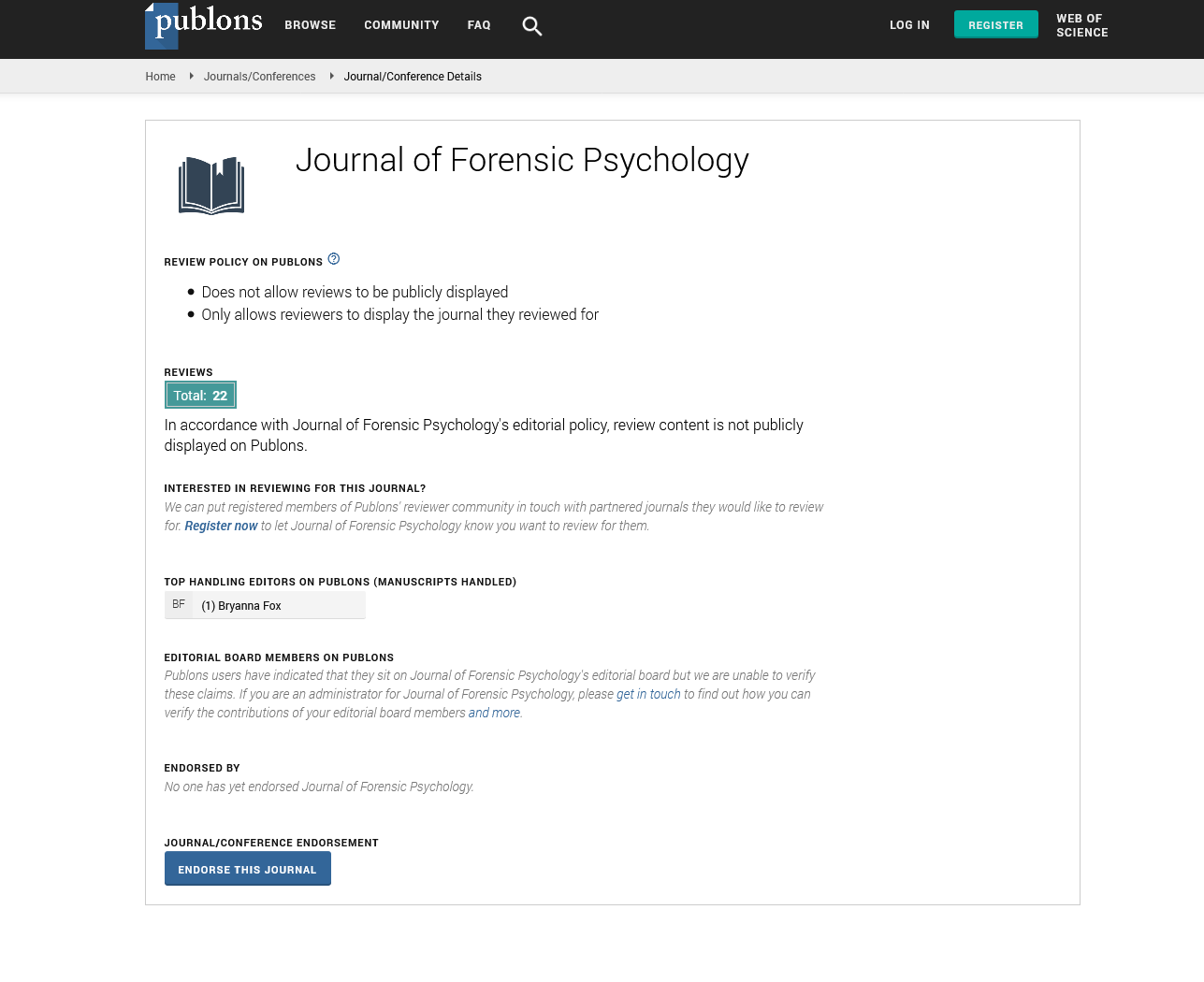Indexed In
- RefSeek
- Hamdard University
- EBSCO A-Z
- Publons
- Geneva Foundation for Medical Education and Research
- Euro Pub
- Google Scholar
Useful Links
Share This Page
Journal Flyer

Open Access Journals
- Agri and Aquaculture
- Biochemistry
- Bioinformatics & Systems Biology
- Business & Management
- Chemistry
- Clinical Sciences
- Engineering
- Food & Nutrition
- General Science
- Genetics & Molecular Biology
- Immunology & Microbiology
- Medical Sciences
- Neuroscience & Psychology
- Nursing & Health Care
- Pharmaceutical Sciences
Commentary - (2024) Volume 9, Issue 5
The Role of Domestic Violence Prediction at the Neighborhood Level
Smith John*Received: 30-Sep-2024, Manuscript No. JFPY-24-28194; Editor assigned: 02-Oct-2024, Pre QC No. JFPY-24-28194 (PQ); Reviewed: 16-Oct-2024, QC No. JFPY-24-28194; Revised: 23-Oct-2024, Manuscript No. JFPY-24-28194 (R); Published: 30-Oct-2024, DOI: 10.35248/2475-319X.24.9.358
Description
Domestic violence is a pervasive issue that impacts millions of individuals worldwide, transcending socioeconomic boundaries, cultural norms and geographic regions. As societies grow more aware of its detrimental effects on victims and communities, the need for early intervention strategies becomes increasingly critical. One such strategy gaining attention is the prediction of domestic violence incidents at the neighborhood level. Utilizing technology and data analysis to forecast domestic violence trends can empower law enforcement, social services and communities to take proactive measures that prevent harm and support victims. However, the effectiveness of this approach depends on balancing ethical considerations, resource allocation and the accurate application of predictive models.
Predicting domestic violence at the neighborhood level holds the potential for significant improvements in public safety and victim protection. Neighborhood-based predictions involve analyzing patterns of crime, socio-economic data, community dynamics and previous domestic violence reports to identify areas at higher risk for such incidents. By examining these patterns, authorities can allocate resources more effectively, placing social workers, police and other support services in areas most in need.
Data-driven predictive models use advanced technologies such as machine learning algorithms and Artificial Intelligence (AI) to process large datasets. These models can highlight underlying factors that may not be immediately apparent to human observers, such as the correlation between domestic violence and local economic stress, unemployment rates, or the presence of substance abuse. By understanding these patterns, local authorities can respond with customized interventions-whether through outreach programs, community awareness campaigns, or more focused law enforcement activities.
A particularly potential application of neighborhood-level prediction is through predictive policing. In some cities, this approach has been used to anticipate high-crime areas and times, allowing police departments to prevent or de-escalate situations before they become violent. In the context of domestic violence, predictive policing can help law enforcement identify not only areas with higher incident rates but also the timing and likelihood of future occurrences, giving them the chance to intervene before a situation escalates to physical harm.
While predictive models hold potential, they are not without their challenges, especially at the neighborhood level. One of the foremost concerns is the potential for reinforcing biases. Machine learning algorithms are only as good as the data they are trained on and if historical data contains bias-such as disproportionate policing in certain neighborhoods-predictions may unintentionally favor certain areas while overlooking others. For example, areas already experiencing heavy law enforcement activity may appear as more prone to domestic violence, even if the data reflects an over-policing effect rather than a true higher incidence of abuse.
Furthermore, there is the risk of stigmatizing entire communities. If a neighborhood is identified as a “high-risk” area, it could lead to a self-fulfilling prophecy, where residents and community leaders become conditioned to expect violence, which could either drive more law enforcement presence or reduce community cohesion. This could undermine the very objective of fostering safer, more supportive communities.
Privacy concerns also arise when collecting and analyzing sensitive data, particularly regarding victims of domestic violence. If predictive models are based on detailed personal data, it is essential to ensure that such information is handled securely and that individuals' privacy rights are protected. The use of personal data must be transparent and subject to strict ethical guidelines, with clear processes in place for addressing potential misuse.
An effective neighborhood-level predictive model must go beyond just identifying where violence may occur; it must also ensure that the right resources are available for prevention and intervention. Predictive models should not replace human insight but rather augment it by providing authorities with deeper insights into local dynamics. This approach could encourage collaboration between law enforcement, social services, healthcare providers and community organizations to ensure that interventions are holistic, responsive and culturally sensitive.
For example, when a prediction indicates a neighborhood is at risk for domestic violence, the community can be mobilized through initiatives such as educational programs, self-defense training and resources to support families experiencing hardship. Neighborhood watch programs, local shelters and counseling services can work together to establish support networks that are activated before violence escalates.
In conclusion, domestic violence prediction at the neighborhood level represents an innovative step forward in tackling this global issue. By using data to identify at-risk areas, authorities can allocate resources more effectively and intervene earlier, potentially preventing violence before it happens. However, this approach must be handled with caution. Ethical concerns, including the potential for bias and the privacy of individuals, must be carefully addressed to avoid harm to the very communities that predictive models seek to protect. Ultimately, the success of domestic violence prediction lies in its ability to integrate technology with a compassionate, community-driven response-ensuring that intervention is both timely and effective in promoting safety and well-being for all.
Citation: John S (2024). The Role of Domestic Violence Prediction at the Neighborhood Level. J Foren Psy. 9:358.
Copyright: © 2024 John S. This is an open-access article distributed under the terms of the Creative Commons Attribution License, which permits unrestricted use, distribution and reproduction in any medium, provided the original author and source are credited.

